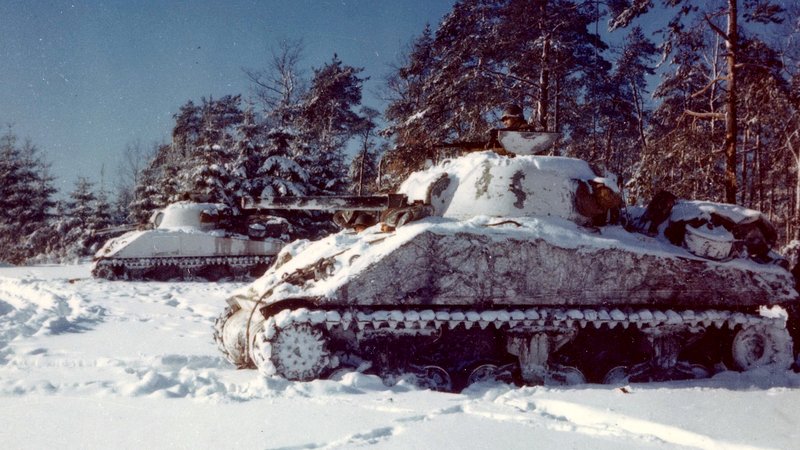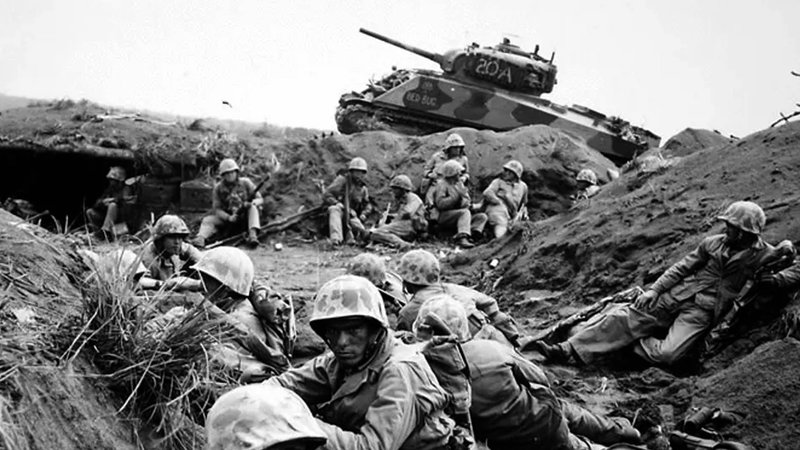
A Marine M4A3 Sherman tank burns a Japanese position on Iwo Jima. US Marine Corps photo by Mark Kauffman, courtesy of Wikimedia Commons.
In the winter of 1864, Union Gen. William Tecumseh Sherman led 62,000 soldiers in the destruction of Atlanta. They burned an estimated 3,000 buildings to the ground — almost the entire city — and then continued their march to Savannah, destroying everything in their path.
Sherman later reflected on the strategy in his memoirs: “War is cruelty. There’s no use trying to reform it. The crueler it is, the sooner it is over.” That philosophy would be embraced by the general’s successors in the era of mechanized warfare, as the American military evolved to become one of the world’s most heavily armed — and devastating — fighting forces.
Among the deadliest war machines devised by the United States military in the 20th century was the M4 medium tank. Developed in the early 1940s, the M4 became the backbone of American armor during World War II. Soon after rolling into battle, it was rechristened the M4 Sherman — a name that would prove especially fitting when it became the first American tank to be armed with a flamethrower.

A formation of American M4 Shermans in Europe. Wikimedia Commons photo,
American Armor in Africa
At the onset of World War II, American military leaders realized their tanks were in desperate need of upgrades. That began to sink in during the fall of 1939, when columns of German tanks steamrolled through Poland in 35 days, and Nazi armored divisions took France the following spring.
Those early victories prompted the United States to begin developing tanks capable of standing up to German armor. In 1941, a new prototype called the T6 rolled off the assembly line, and before long the tank was being shipped to British forces fighting in Africa. In the British tradition of naming American-leased tanks after famous American generals, the T6 was christened “the Sherman.”
Initial feedback from the front lines was positive. In time, several minor adjustments to the design were made — notably, the tank’s side hatch was removed and a second top hatch was added. This allowed the welded hull to be constructed as one solid piece of metal, making the tank cheaper to mass-produce than the prototype. The final design was officially called the M4 medium tank, but the Sherman nickname stuck as its numbers on the battlefield grew.

M4 Sherman tanks of the 40th Tank Battalion in a snow-covered field near Saint Vith, Belgium. US National Archives photo.
The US began mass-producing Shermans in August 1942. Three months later, the first American-operated Shermans saw combat in the Allied invasion of North Africa, also known as Operation Torch. There, the Sherman proved a worthy adversary to German medium tanks, like the MkII and MkIV Panzers. But it was still no match for the larger, better-armored Panther and Tiger. To compensate for this disparity, the US focused on volume, using its industrial might to produce an estimated 50,000 Shermans over the next three years.
Related: Combat Tea Party: Why Tea Kettles Are Installed in British Army Tanks
The Bizarre Shermans of D-Day
On June 6, 1944, a combined Allied force of American, Canadian, and British troops landed in Normandy, beginning the push across France and into Germany. They came armed with an assortment of specially equipped M4 Shermans designed for various roles in the invasion.
Some tanks, dubbed “crab” Shermans, had large, flailing chains affixed to their front ends. The strange-looking machines were engineered for the job of clearing pathways through minefields, not unlike the mine rollers used today.

An M4A3 Sherman equipped with deep water wading gear. Wikimedia Commons photo.
Other variations, including the Sherman Duplex Drive, were called “swimming tanks.” These were launched 2 miles from shore to avoid German artillery and slowly motored to the beach with two small propellers. They proved effective on three D-Day beaches — Sword, Gold, and Juno — but many of the ones used in the assaults on Utah and Omaha sank to the bottom of the English Channel.
The Churchill Arch was another unique model designed for amphibious operations. In place of a main gun, the tank was armed with a deployable ramp. This allowed other swimming Shermans to clear large obstacles such as seawalls by driving over the Churchill Arch.

A mired M4 Sherman tank on a Normandy invasion beach, June 12, 1944. Wikimedia Commons photo.
Following the D-Day landings, unmodified Sherman tanks armed with their standard 75mm main guns continued to play a crucial role in the invasion and helped pave the way to Allied victory in Europe.
Related: Death Metal: Five Great Books About Tank Warfare
Sherman’s March to Victory
The primary role of Sherman tanks in WWII was to support the infantry. They were relatively small vehicles, roughly 20 feet in length. The metal hull carried a five-man crew: a commander, a driver, a loader, a gunner, and a bow gunner.
Despite having thinner armor and less firepower than most German tanks, the simple design of the M4 proved to be well suited for fast-moving offensive operations. Sherman tank crews could fix their own tanks in the field, rather than relying on rear-echelon mechanics to replace parts or troubleshoot the sort of complex problems that came with more intricate designs.

A British Sherman tank of the 23rd Armoured Brigade coming ashore from a landing craft at Anzio, Jan. 22, 1944. Wikimedia Commons photo.
During the Battle of the Bulge, for example, Sherman tanks managed to outperform German armor largely because they required less fuel and less maintenance. Many of the formidable Tiger and Panther tanks became useless after German supply lines were severed.
The M4 Sherman did have one critical vulnerability: It was prone to catching fire when damaged. This was a big enough issue that American tank crews began calling Shermans “Ronsons” after a popular lighter company.
Related: WATCH: This World War II Churchill Crocodile Tank Spit Liquid Fire
European Ronsons, Pacific Zippos
Meanwhile, in the Pacific theater, American GIs had started calling the Sherman by another nickname borrowed from a popular lighter company — Zippo — but for a much different reason than their counterparts in Europe.
Just like on the beachheads of Europe, the Sherman’s versatility proved indispensable to Allied commanders. One unique challenge of fighting on the Pacific islands was that Japanese soldiers often operated from the cover of deep cave complexes. These natural fortresses were extremely difficult to penetrate with conventional infantry weapons like rifles and machine guns. So the Americans came to rely on flamethrowers to do the job.

Marine privates Richard Klatt, left, and Wilfred Voegeli fire M2 flamethrowers during the battle of Iwo Jima. US Marine Corps photo, via Wikimedia Commons.
US soldiers and Marines carried the M2 flamethrower. The bulky, hand-held weapon could incinerate a target from a distance of more than 65 feet, but its 2-gallon fuel tank only lasted for seven seconds. Medal of Honor recipient Hershel Williams had to retrieve new flamethrowers five times in one afternoon during the Battle of Iwo Jima.
Another problem with the M2 was that flamethrower operators were so effective that they became high-value targets. One flamethrower unit on Iwo Jima suffered a casualty rate of 92%. During the battle, the average life expectancy of a flamethrower operator was estimated at just four minutes.

Marines from the 24th Marine Regiment rest near a camouflaged M4A3 Sherman tank during the Battle of Iwo Jima. Wikimedia Commons photo.
To reduce their reliance on hand-held flamethrowers, the Americans started modifying Sherman tanks to shoot flame instead of explosives. The M4A3 “Zippo” tank could fire jellied gasoline 150 yards. On Iwo Jima, Zippos dispensed an average of 10,000 gallons of napalm per day for the duration of the battle. They were again used to devastating effect in the Battle of Okinawa.
Sherman tanks remained in service through the Korean War. Then, in 1957, the US Army began replacing them with better models. The M47 Patton, the M48 Patton, and the M60 Patton eventually usurped the Sherman’s place as America’s main battle tanks. Today, the Sherman is only a museum piece, but just like its namesake, its legacy will forever be synonymous with American battlefield dominance.
Read Next: Meet Russia’s Most Advanced Tank (and Why the US Army Isn’t Worried About It)

Mac Caltrider is a senior staff writer for Coffee or Die Magazine. He served in the US Marine Corps and is a former police officer. Caltrider earned his bachelor’s degree in history and now reads anything he can get his hands on. He is also the creator of Pipes & Pages, a site intended to increase readership among enlisted troops. Caltrider spends most of his time reading, writing, and waging a one-man war against premature hair loss.
BRCC and Bad Moon Print Press team up for an exclusive, limited-edition T-shirt design!
BRCC partners with Team Room Design for an exclusive T-shirt release!
Thirty Seconds Out has partnered with BRCC for an exclusive shirt design invoking the God of Winter.
Lucas O'Hara of Grizzly Forge has teamed up with BRCC for a badass, exclusive Shirt Club T-shirt design featuring his most popular knife and tiomahawk.
Coffee or Die sits down with one of the graphic designers behind Black Rifle Coffee's signature look and vibe.
Biden will award the Medal of Honor to a Vietnam War Army helicopter pilot who risked his life to save a reconnaissance team from almost certain death.
Ever wonder how much Jack Mandaville would f*ck sh*t up if he went back in time? The American Revolution didn't even see him coming.
A nearly 200-year-old West Point time capsule that at first appeared to yield little more than dust contains hidden treasure, the US Military Academy said.












